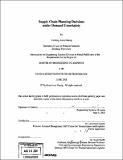| dc.contributor.advisor | Lawrence Lapide. | en_US |
| dc.contributor.author | Huang, Yanfeng Anna | en_US |
| dc.contributor.other | Massachusetts Institute of Technology. Engineering Systems Division. | en_US |
| dc.date.accessioned | 2009-04-29T17:11:49Z | |
| dc.date.available | 2009-04-29T17:11:49Z | |
| dc.date.issued | 2008 | en_US |
| dc.identifier.uri | http://hdl.handle.net/1721.1/45229 | |
| dc.description | Thesis (M. Eng. in Logistics)--Massachusetts Institute of Technology, Engineering Systems Division, 2008. | en_US |
| dc.description | "June 2008." | en_US |
| dc.description | Includes bibliographical references (leaves 68-71). | en_US |
| dc.description.abstract | Sales and operational planning that incorporates unconstrained demand forecasts has been expected to improve long term corporate profitability. Companies are considering such unconstrained demand forecasts in their decisions on investment in supply chain resources. However, demand forecasts are often associated with uncertainty. This research applies Monte Carlo simulation, value at risk and gain curve analysis, and real option analysis to investigate how the uncertainty of demands affects supply chain planning in order to make better supply chain investment decisions. This analytical framework was used to analyze the ocean shipping plans and inland trucking arrangements for Chiquita. Demands for Product A and front haul over a six-year period were simulated based upon forecasted distributions. The net income, revenue and costs as affected by ocean shipping plans were obtained by inputting the simulated demands to ocean shipping models. The major decision for Chiquita is whether to charter one large ship or two ships which provide approximately equivalent capacity. A large ship would save fuel costs. The plans for two smaller ships have the flexibility of using one ship only if future demand or price reactions warrant it. Using the analytical framework, a plan for two smaller ships is superior to that for one large ship because of significant real option value, particularly in the event of increases in fuel costs in the future. Chiquita's current inland trucking model, a mixed arrangement with a dedicated fleet and common carriers, seems to offer a good solution for the future needs. A model provided in this research offers a simple method to optimize the size of the dedicated fleet. | en_US |
| dc.description.statementofresponsibility | by Yanfeng Anna Huang. | en_US |
| dc.format.extent | 76 leaves | en_US |
| dc.language.iso | eng | en_US |
| dc.publisher | Massachusetts Institute of Technology | en_US |
| dc.rights | M.I.T. theses are protected by
copyright. They may be viewed from this source for any purpose, but
reproduction or distribution in any format is prohibited without written
permission. See provided URL for inquiries about permission. | en_US |
| dc.rights.uri | http://dspace.mit.edu/handle/1721.1/7582 | en_US |
| dc.subject | Engineering Systems Division. | en_US |
| dc.title | Supply chain planning decisions under demand uncertainty | en_US |
| dc.type | Thesis | en_US |
| dc.description.degree | M.Eng.in Logistics | en_US |
| dc.contributor.department | Massachusetts Institute of Technology. Engineering Systems Division | |
| dc.identifier.oclc | 304398191 | en_US |
